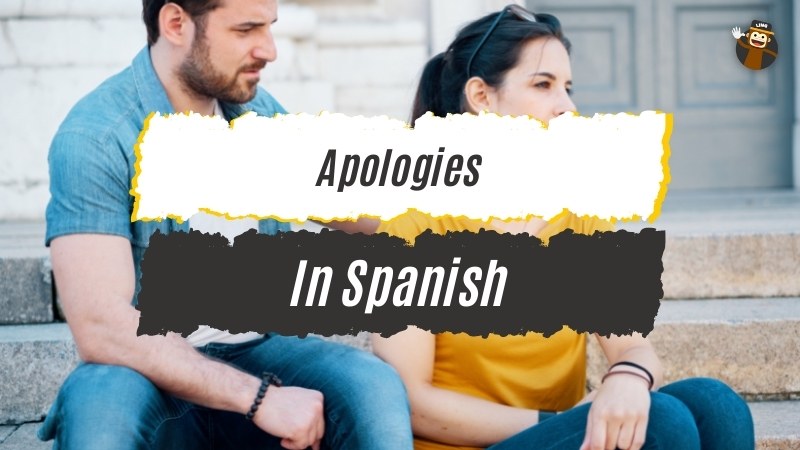Do you know all the apologies in Spanish? You should! During your trip through Hispanic countries, you may experience certain situations where you will be required to apologize.
Imagine you visit a beautiful Catholic Church and decide to take pictures. You don’t realize that a small baptismal mass is taking place, much less do you notice your camera flash. Someone approaches you to ask you not to take pictures during the mass, and with great shame, you cannot express in Spanish how sorry you are.
In cases like these, knowing a few essential words in the language of the country you are visiting can save you from many uncomfortable situations. It’s hard enough for people to apologize. More if you have made a mistake in a foreign country.
It has happened to me several times, and just by remembering it, I feel the embarrassment come to me once again! But I must also admit that I feel much better when I accept my mistakes and apologize. I can certainly make the other person feel good as well.
When I travel, I always make sure I know how to say hello, please, thank you, and sorry.
If you are ready to learn how to apologize in Spanish, here’s what we will cover in today’s post:
- Apologizing in Spanish
- Five main Spanish verbs to apologize
- Other possible ways to apologize In Spanish
Apologizing In Spanish: Meaning
An apology is a necessary action that allows us to express when we are sorry for the negative situation we have caused someone else and restore dignity to those we hurt.
Although our actions may not have been on purpose, it is necessary to be aware of what happened and the effects of our actions.
Now, apologizing can become a bit more tricky in the Spanish language. We have many terms for apologizing that can have different connotations depending on the situation. Therefore, you must know each of them and become familiar with the contexts.
In a nutshell, the first phrases you should understand are the following:
Ask for forgiveness:
- Pedir disculpas
- Pedir perdón
To say sorry, to apologize, or to forgive:
- Disculpar
- Perdonar
But there’s more! Keep reading.
Apologies In Spanish: The 5 Main Verbs To Say Sorry
Start apologizing to people in their native language so that you can win their hearts quicker. After learning these Spanish words and phrases, you will start sounding like a native speaker in no time.
Let’s go through the following phrases and their meanings:
- Perdóneme/Perdón (Sorry/Excuse me)
- Lo Siento (I’m sorry)
- Discúlpeme (My apologies)
- Lo Lamento (I’m sorry)
Note: This lesson will cover both the formal and informal ways of saying sorry, the meaning of each term and some examples of when to use these terms.
1. Perdóneme – Formal (Pardon Me)
From the verb: Perdonar (To forgive)
When visiting a Spanish-speaking country or having Spanish-speaking friends, you will often hear the verb ‘perdonar’ being used to apologize. It is our most used way to express how sorry we are.
In my personal opinion, every time I need to apologize to someone, I always choose to say ‘Perdóname’ or any of its related terms such as ‘me perdonas?’ (can you forgive me?), because it is easier for me to say this phrase.
It sounds sincere and expresses everything that I wish to convey to the other person.

Variants:
Perdóname – Informal (I’m sorry)
‘Perdóname’ has the same meaning, but it is used only in informal situations, with your friends, family, or anyone you are close with.
Another important fact for you to know is that there are some countries where people don’t use formal terms, so it would depend on where you are.
Perdone – Formal (Forgive me)
You can use this interchangeably with ‘perdóneme’ as they are both formal ways to apologize to your superiors, elderly people, or someone you don’t know well.
Perdona – Neutral (Forgive me)
This variant can also be used with close people. Although, some people do say ‘perdona’ to strangers because it is not informal nor formal. It is more like a neutral term that sounds polite enough to use with strangers.
Perdón – Neutral (Forgiveness)
This noun can be used in any context. You can say ‘perdón’ when you make a mistake, and you can say it also if someone has blocked your way and you need space to pass.
- Perdón, se que lo que hice estuvo mal. (Forgive me, I know what I did was wrong.)
- Perdón, necesito pasar. (Sorry, I need to pass.)
Perdón por – Neutral (I’m sorry for)
Whenever you need to explain your mistake, you can say ‘perdón por…’ and add your explanation. This way, the other person will understand why you are apologizing.
- A: Perdón por mi mal comportamiento. (Sorry for my bad behavior.)
- B: Te perdono. (I forgive you.)
2. Lo Siento – Formal & Informal (I’m Sorry)
Verb:Sentir (To feel)
Another widely used form of apologizing in Spanish is ‘Lo siento.’ It is preferred by many people not only because it can be said in formal and informal situations but also because it allows the person to express the remorse they have been feeling for their actions.
If the person saying ‘lo siento’ isn’t the culprit, it might be that they feel bad for something that they witnessed. So, they want to convey that they know what the other person is going through.
The literal translation of ‘lo siento’ is ‘I feel it.’ You feel emotions about the situation, your actions and their effects on someone else.
As a native speaker, I feel like people who can easily ask for forgiveness choose to say ‘lo siento’ instead of ‘perdón,’ since it connotes more feelings. So, people who can’t express feelings may not use this form unless they say it to someone familiar.
Lo siento (I’m sorry. The literal translation is: ‘I feel it.’)
- Lo siento por lo que te pasó. (I’m sorry for what happened to you)
- Lo siento, de verdad no quice hacerlo… (I’m sorry, I really didn’t mean to do it.)
- De verdad lo siento por romper tu florero favorito. (I’m really sorry for breaking your favorite vase.)
‘De verdad’ (really) can be used to reassure that you indeed feel sorry and will not stop until you are forgiven.

Variants:
Lo siento mucho (I’m so sorry)
Lo siento mucho por lo que has estado pasando. (I’m so sorry for what you have been going through.)
- Lo siento mucho por mentirte. (I’m so sorry for lying to you.)
You can also say ‘muchísimo’ (very much), which helps you emphasize how much you are sorry.
- Lo siento muchísimo, no fué mi intención. (I’m so sorry, I didn’t mean to.)
If you want to explain why you are saying sorry, add your reason after saying ‘siento.’ For example:
- Siento llegar tan tarde a nuestra cita. (I’m sorry for being late to our date.)
Here you are saying that you feel bad for having the person waiting for so long before your date.
Another example:
- Siento mucho que mi perro se haya comido tu tarea. (I’m so sorry my dog ate your homework.)
3. Discúlpeme – Formal (Forgive me/Excuse me)
Verb: Disculpar (To forgive, to excuse)
‘Discúlpeme’ is commonly used to say ‘excuse me.’ But it is also a form to apologize for committing a mistake.
An excellent example of when I would use this term is if, for example, my professor asks me to pass him a pen, but when giving it to him, it falls to the floor. I will quickly say ‘uy, discúlpeme.’ I would proceed to pick it up and ensure that the pen does reach his hand this time.
Another example:
Discúlpeme, pero no puedo responder a su pregunta. (Excuse me, but I cannot answer your question.)
Let’s learn two essential terms related to this word.
- Disculpas (Apologies)
- Disculpas aceptadas. (Apologies accepted.)
- Mis disculpas. (My apologies.)
- Pedir disculpas (Apologize)
- ¡Ve a pedir disculpas a tu papá! (Go apologize to your dad!)

Variants:
Disculpe – Formal (Excuse me/Forgive me)
As with the other formal phrases that we have previously discussed, you should only use ‘disculpe’ when talking with elder people, superiors such as your boss, or people you don’t know.
Some countries have the tradition of speaking formally with their parents and grandparents. So you may listen to people using this form in a familiar context. If you get confused by this, my only advice is to go along with what natives do.
- Disculpe, me podría ayudar a encontrar mi hotel, por favor? (Excuse me, could you help me find my hotel, please?)
- Disculpe, me equivoqué de número. (Sorry, I got the wrong number.)
In that sentence, I wrote ‘podría’ (could you – formal) and not ‘podrías‘ (could you – informal).
Disculpa – Informal (Excuse me/Forgive me)
- Disculpa, no alcancé a contestar el teléfono a tiempo. (Sorry, I didn’t get to answer the phone in time.)
- Discúlpa a mi hija, es un poco traviesa. (Excuse my daughter, she’s a bit naughty.)
Disculpa por… (Excuse me for/Sorry for…)
- Discúlpa por tanto ruido en mi casa. Hay una construcción a lado. (Sorry for so much noise in my house. There is a construction next door.)
Lo Lamento – Neutral (I’m sorry)
Verb: Lamentar (To regret)
Saying ‘lo lamento’ allows you to express your deep regret. In addition, many people usually use this term together with ‘discúlpeme.’
For example:
- Discúlpeme, lamento mucho lo sucedido. (Excuse me, I’m very sorry about what happened)
- Discúlpame, lamento mucho interrumpirte. Necesito decir algo. (Excuse me, sorry to interrupt you. I need to say something.)

Variants:
- Lamento lo sucedido con tu familia. (I’m sorry about what happened to your family.)
Lo lamento mucho… – Neutral (Sorry…)
- Lamento mucho tu pérdida. (I am very sorry for your loss.)
Lamento que…- Neutral (I’m sorry that…)
- Lamento que tuvieras que irte tan temprano. (I’m sorry you had to leave so early.)
Other Phrases To Apologize In Spanish
- ¡Cuánto lo siento! (I’m so sorry! Literal translation: How sorry I am!)
- Lo siento, pero… (I’m sorry, but…)
- Me arrepiento de… (I regret…)
- Mil disculpas. (Apologies. It literally means ‘a thousand apologies.’)
- ¿Me perdonas? (Do you forgive me?)
- ¿Podrás perdonarme? (Could you forgive me?)
- ¿Podrías perdonarme? (Would you forgive?)
- Por favor perdóname (Please forgive me)
- Haré lo que sea para que me perdones. (I will do whatever it takes for you to forgive me.)
- Te debo una disculpa. (I owe you an apology)
- Mi más sentido pésame. (My deepest condolences.)
- Le ruego me disculpe. (I beg your pardon.)
Now You Know How To Say Sorry In Spanish!
Congratulations! Knowing how to apologize in Spanish is a big step in your Spanish learning. And now you know all the apologies in Spanish to use in different situations. Which one will you use? That would depend on your feelings and preference!
You will often use at least one of these phrases while traveling abroad or talking with Spanish speakers.
Many people will agree that apologizing can be difficult in any language. But being able to say sorry to someone in their native tongue can make things so much easier between you two!
Are You Ready For A Unique Form Of Learning Spanish?
I hope you are ready because Ling is here to meet your language learning expectations. If you’ve been looking for an app to learn Spanish, try Ling today! You will love how this cost-effective app manages to guide you from basic to advanced levels with fun lessons, realistic conversations, and engaging quizzes.
Ling App has been created with a simple but efficient concept. Our purpose is to allow you to learn a bit of your favorite language every day. Everything you learn in the app will remain in your memory. It is because you will learn by practical experience and not memorization.

You will love having daily life conversations with our chatbot! Especially if you have trouble engaging in conversations with Spanish native speakers. You will see how all your skills drastically improve!
And if that isn’t enough, at Ling Blog, we always cover valuable topics related to language and culture. We think every Spanish learner should know these topics during their journey to achieve fluency. While doing your Spanish lessons with Ling App, enrich your knowledge by reading about Spanish verbs, Love Words, adjectives, and proverbs.
Download the Ling App today and begin your journey!










